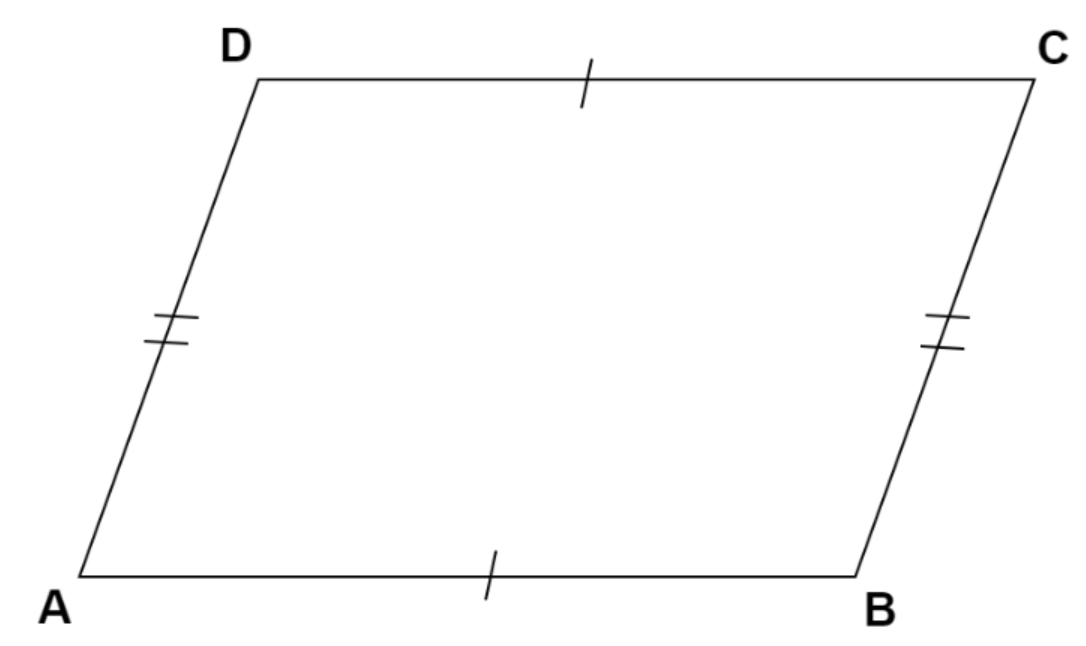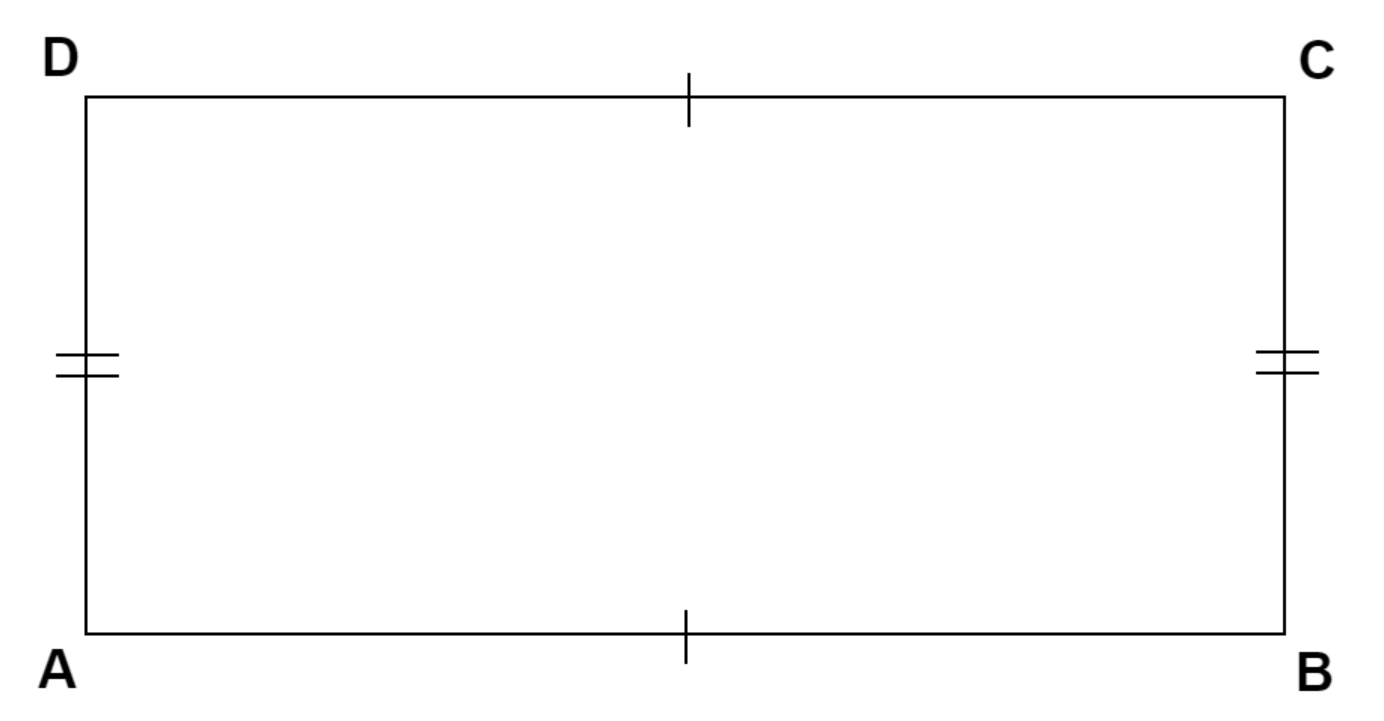
Which quadrilaterals have \[2\] pairs of parallel sides?
Answer
463.8k+ views
Hint: Parallel lines are the lines which do not intersect each other at any point of the plane. They are equidistant from each other. We need to find the quadrilaterals that have two pairs of parallel lines. A parallelogram is usually defined as a quadrilateral with two pairs of parallel lines. A quadrilateral is a polygon with four sides. So, to find the quadrilateral with two pairs of parallel sides, we need to find a polygon of four sides with two pairs of parallel lines.
Complete answer:
Since a parallelogram is a quadrilateral with two pairs of parallel lines, one of these quadrilaterals is a parallelogram. Let us see it through a diagram.

Here, \[ABCD\] is a parallelogram with \[AB||CD\] and \[AD||BC\].
So, we get two pairs of parallel lines.
Now, let us consider the types of Parallelogram.
First, Let us consider Rhombus.
Let us draw a rhombus.

A Rhombus is a special type of parallelogram with all sides equal. Here, \[ABCD\] is a rhombus with \[AB||CD\] and \[AD||BC\].
Hence, we see that a rhombus has two pairs of parallel lines.
Now, let us consider another type of a parallelogram. i.e. Rectangle.
Let us draw a rectangle.

A rectangle is a special type of parallelogram where measure of all the angles is equal to \[{90^ \circ }\]. In this figure above, \[ABCD\] is a rectangle with \[AB||CD\] and \[AD||BC\].
So, we see that a rectangle also has two pairs of parallel lines.
Now, let us consider another type of parallelogram. i.e. Square
Let us draw a square now.

A Square is a special type of parallelogram with all sides equal and the measure of all the angles is equal to \[{90^ \circ }\]. Here, \[ABCD\] is a square with \[AB||CD\] and \[AD||BC\].
So, we see that a square also has two pairs of parallel lines.
Hence, we can say that the quadrilaterals with two pairs of parallel lines are Parallelogram, Rhombus, Rectangle and Square.
Note: First of all, we need to understand the question. It is given that we need to find a quadrilateral with two pairs of parallel lines which means that total there will be four lines out of which two are parallel to each other and other two are parallel to each other. Now, we think that except these four lines, can we have any other lines since the condition that two pairs of parallel lines are needed is satisfied? The answer is NO, since it is given that we need to find the quadrilaterals and quadrilaterals have only four sides.
Complete answer:
Since a parallelogram is a quadrilateral with two pairs of parallel lines, one of these quadrilaterals is a parallelogram. Let us see it through a diagram.

Here, \[ABCD\] is a parallelogram with \[AB||CD\] and \[AD||BC\].
So, we get two pairs of parallel lines.
Now, let us consider the types of Parallelogram.
First, Let us consider Rhombus.
Let us draw a rhombus.

A Rhombus is a special type of parallelogram with all sides equal. Here, \[ABCD\] is a rhombus with \[AB||CD\] and \[AD||BC\].
Hence, we see that a rhombus has two pairs of parallel lines.
Now, let us consider another type of a parallelogram. i.e. Rectangle.
Let us draw a rectangle.

A rectangle is a special type of parallelogram where measure of all the angles is equal to \[{90^ \circ }\]. In this figure above, \[ABCD\] is a rectangle with \[AB||CD\] and \[AD||BC\].
So, we see that a rectangle also has two pairs of parallel lines.
Now, let us consider another type of parallelogram. i.e. Square
Let us draw a square now.

A Square is a special type of parallelogram with all sides equal and the measure of all the angles is equal to \[{90^ \circ }\]. Here, \[ABCD\] is a square with \[AB||CD\] and \[AD||BC\].
So, we see that a square also has two pairs of parallel lines.
Hence, we can say that the quadrilaterals with two pairs of parallel lines are Parallelogram, Rhombus, Rectangle and Square.
Note: First of all, we need to understand the question. It is given that we need to find a quadrilateral with two pairs of parallel lines which means that total there will be four lines out of which two are parallel to each other and other two are parallel to each other. Now, we think that except these four lines, can we have any other lines since the condition that two pairs of parallel lines are needed is satisfied? The answer is NO, since it is given that we need to find the quadrilaterals and quadrilaterals have only four sides.
Recently Updated Pages
Master Class 12 Business Studies: Engaging Questions & Answers for Success

Master Class 12 Economics: Engaging Questions & Answers for Success

Master Class 12 English: Engaging Questions & Answers for Success

Master Class 12 Maths: Engaging Questions & Answers for Success

Master Class 12 Social Science: Engaging Questions & Answers for Success

Master Class 12 Chemistry: Engaging Questions & Answers for Success

Trending doubts
What is BLO What is the full form of BLO class 8 social science CBSE

Citizens of India can vote at the age of A 18 years class 8 social science CBSE

Full form of STD, ISD and PCO

Right to vote is a AFundamental Right BFundamental class 8 social science CBSE

Summary of the poem Where the Mind is Without Fear class 8 english CBSE

What is the difference between rai and mustard see class 8 biology CBSE




